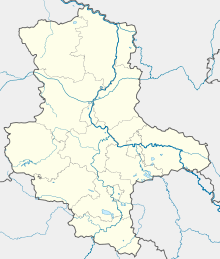| Sack of Magdeburg | |||||||||
|---|---|---|---|---|---|---|---|---|---|
| Part of the Swedish phase of the Thirty Years' War | |||||||||
 Sack of Magdeburg, 1632 engraving by D. Manasser, putting the blame on the citizens' disobedience | |||||||||
| |||||||||
| Belligerents | |||||||||
|
Holy Roman Empire Catholic League | Magdeburg | ||||||||
| Commanders and leaders | |||||||||
|
Count of Tilly Graf zu Pappenheim |
Dietrich von Falkenberg † Christian William (POW) | ||||||||
| Strength | |||||||||
|
24,000 during the siege 40,000 during the sack | 2,400 | ||||||||
| Casualties and losses | |||||||||
| 25,000 defenders and inhabitants | ||||||||
Location within Saxony-Anhalt | |||||||||
The sack of Magdeburg, also called Magdeburg's Wedding (German: Magdeburger Hochzeit) or Magdeburg's Sacrifice (Magdeburgs Opfergang), was the destruction of the Protestant city of Magdeburg on 20 May 1631 by the Imperial Army and the forces of the Catholic League, resulting in the deaths of around 20,000, including both defenders and non-combatants. The event is considered the worst massacre of the Thirty Years' War. Magdeburg, then one of the largest cities in Germany, having well over 25,000 inhabitants in 1630, did not recover its importance until well into the 18th century.

